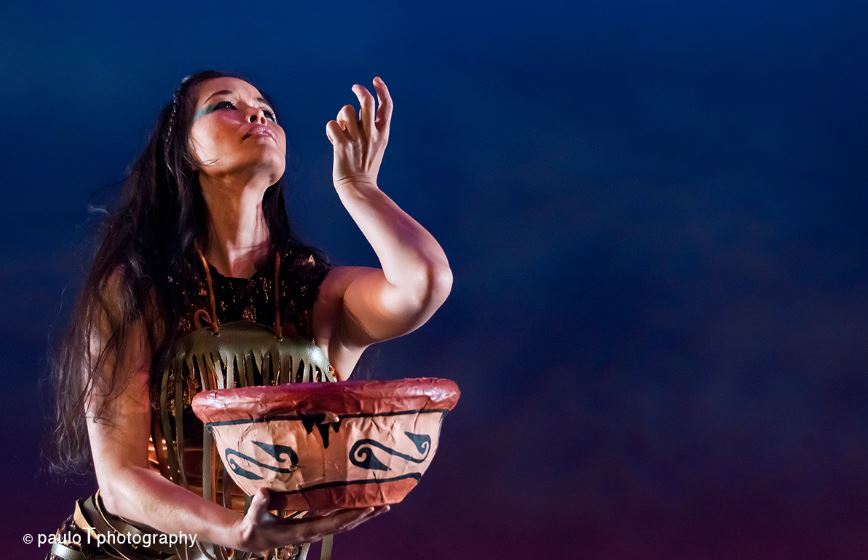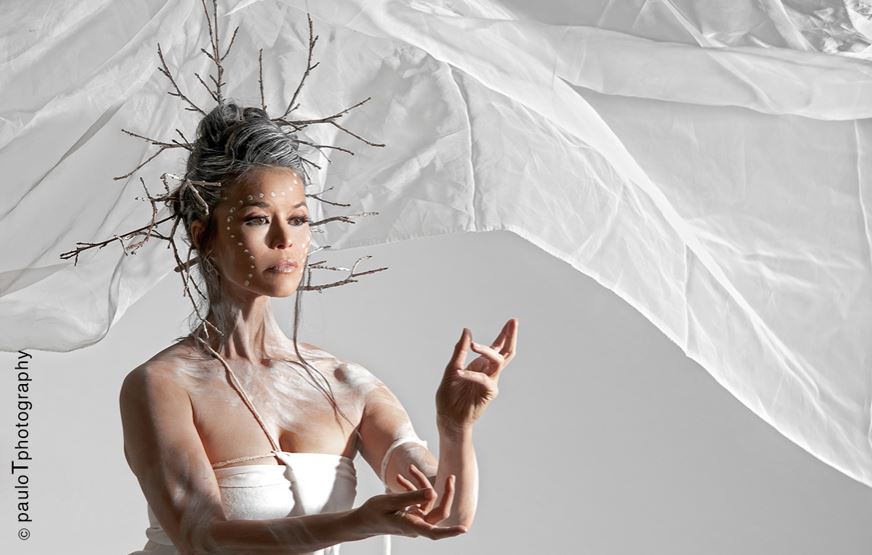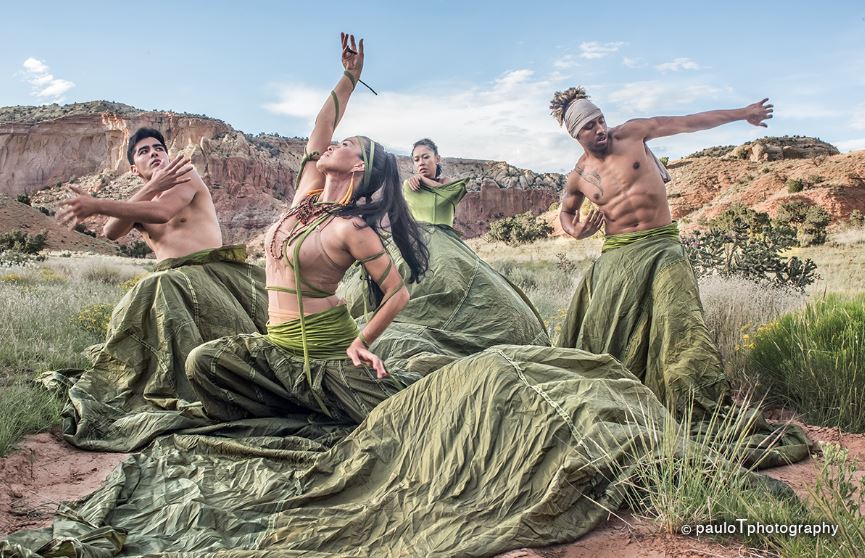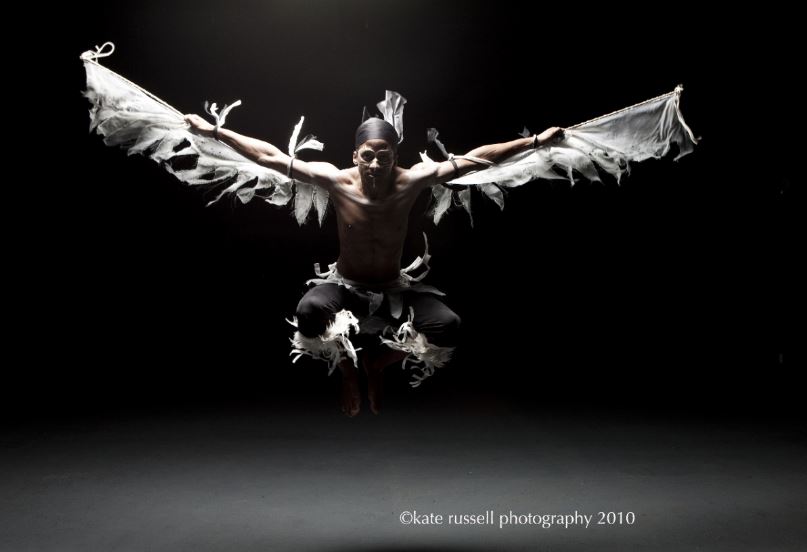Defining Indigenous Contemporary Dance, One Step at a Time
An Interview with Rulan Tangen
BY EMMALY WIEDERHOLT
Rulan Tangen is the artistic director and founder of Dancing Earth, an indigenous intertribal dance ensemble based out of New Mexico. Her work values movement as an expression of indigenous worldview, including the honoring of matriarchal leadership, dance as functional ritual for transformation and healing, the process of decolonizing the body, and the animistic energetic connection with all forms of life. Here, she shares her journey, process and outlook.
~~
Growing up, did you have indigenous mentors in dance?
I had a fairly chaotic childhood with a lot of unpredictability, so I fell in love with ballet because of its discipline and precision. I wasn’t that gifted, but I worked incredibly hard. I moved to New York when I was 15, where I had a 10-year career. I danced ballet professionally and then shifted organically into contemporary dance, which included touring to Europe with Michael Mao Dance.
I had one mentor at Peridance Ensemble, Miguel Valdez Mor from the Graham Company, who was of Apache and Mexican heritage. While there were other people of color around me, Miguel was my first exposure to dance with a different cultural aesthetic and value system. We worked closely together, and he encouraged me to go to my own culture source.
It was a long journey, but I returned to my roots by becoming a powwow dancer. I spent many summers travelling across the plains and eastern woodlands in powwow dance circles as a women’s traditional dancer.
How did powwow influence your understanding of ballet, and vice versa?
Both are very classical forms: formal, rigorous, innately tied to music, with very precise lines and aesthetics. Both have been preserved, and have also inspired forms of contemporary ballet or women’s fancy shawl dance, that are more individualistic. There is of course the difference – sometimes subtle, sometimes more extreme – of dancing for an audience rather than a community. But what was wanting to emerge from me, or rather through me, was something that felt very ancient and primal, but also very physical, grounded and interpretive of indigenous worldview, philosophies and connection with earth.
For me, ballet and powwow were completely separate dance forms for a long time, but I wanted to try to combine them. I wanted to do the fanciest, showiest and most movement-oriented powwow dances, but the grandmother Geraldine who was mentoring me wanted me to do the most ancient and traditional women’s dances. These dances had very limited movement and were like the essence, the heartbeat of the earth. A lot of the dances had to do with how the regalia moved. I learned that in the making and sharing of the regalia, you learn to be an active, generous and creative part of a community.
We made our regalia entirely from nature: from bones, shells and hide. We weren’t just wearing those elements on top of us; we were connected to those elements. The shape and size of the deer became the length of the fringe. We animated the spirit of the animal, or maybe its more like we were animated by that animal’s spirit. I had always felt my dance practice to be a special ritual, but I started to grow an understanding of it being a ritual for the earth, for life itself.
I had the opportunity to travel to Canada, which is much further along in the development and practice of indigenous contemporary dance. Two of the frontrunners of the movement – Raoul Trujillo and Rosalie Jones – invited me to be part of their projects. Those works were respectively called “Tribe” and “No Home but the Heart.”
As far as my own work, I was experimenting a bit, but I wanted to work with a group, not on myself. I felt like I had to grow my tribe of dancers through teaching, which is also how I started to build my community. For a long time, I was on the road teaching in the Apache, Pueblo and Dakota territories. Slowly, people started to see the value of what I was doing for the young people. They started to see the potential for Native philosophies to be translated into movement.
Finally, Grandmother Geraldine told me: Any of these crazy dances you do that can keep the young ones involved in the culture, go ahead and do it. That’s when I felt like I had permission. This threshold also happened the year I got cancer. Looking back, it’s almost like it was an initiation. It’s a pattern I’ve seen: illness bringing a person to service. Being ill, I learned how to receive. I had gratitude for the many people who helped me heal.
When I finished being sick, I could barely move, but I still had to make a living. Out of sympathy, people offered me dance engagements. Since I couldn’t dance, I brought in young people I’d been teaching, and started to experiment with them. It ultimately became direction and choreography. This was in 2004.
By 2006, elders started to ask me to make dances. For four years, it was almost always dances about water. Quite early in the development of Dancing Earth, we lived up to our name by being ecologically focused. Our first goal was to simply show indigenous people as contemporary people. It started with: “We are still here,” and soon morphed into: “We are still here, and here is what we’ve always danced about.” We’ve always danced on behalf of the health of the planet.
How has positioning yourself in the Southwest influenced your work, as opposed to if you had stayed in New York?
I was distracted when I lived in New York by the wonderful task of being a professional dancer for other choreographers and companies; I couldn’t have done this work in that environment. What I realize now is that what I’ve been trying to evoke is bigger than me. It’s about balancing my internal spirit with the spirit around me. I realized that what was around me was the language of skyscrapers. I’d go to Central Park, but it wasn’t enough. While I do have an appreciation for manmade beauty, I felt like something more elemental was calling me. I felt out of sync.
Based on pictures I’d seen of the Southwest, I felt a magnetizing pull to the landscape for a long time. Until then, my whole life had been about following the job. After leaving New York and working across the country and in Canada, I took a chance and came to New Mexico. Within 45 minutes of arriving, I found myself in community being offered teaching jobs. That’s how I knew I had something to give here. It’s a very indigenous way of seeing things: “What do I have to give?”, instead of “What can I take?”
Have you experienced a difference in the reception of your work in rural versus urban environments?
We’ve been blessed to take our work to 15 states and seven countries. We can go to a very rural town and perform at a local gymnasium packed with people who may have never seen live theater, but they might understand that we’re making a dance to transform understanding about water. While we can get that appreciation for ecological justice in urban scenarios too, there’s often a lot more going on. It can be harder to catch attention in a crowded, busy city, but also very special.
In either instance, I think what’s interesting is the indigenizing of space. Wherever we land, we try to claim the space on indigenous terms. We make contact with the first nations of that community, and ask for permission to be on that land. That process usually ends with building relationships. It’s powerful, but a lot of work. It takes culturally competency.
How would you describe the work you do today?
I call it an intertribal aesthetic. It’s a delicate negotiation, because it doesn’t impose one world view. We can’t simply tell an Apache story, for instance, because perhaps it would be more appropriate for all Apache collaborators to be telling it. That being said, I’ve been invited into communities to create tribally specific work. But, since Dancing Earth is intertribal, the entire process is a negotiation with regards to what I invite my dancers to contribute culturally or creatively.
Rather than assuming we’re all the same, can we not be aware of each other’s differences, and still be respectful and appreciative? I see it like we’re standing in a big circle, and every perspective along the circle sees differently. It’s very important that we hold those differences of perspective and respect each other for them.
How do you negotiate the perceived difference between classical dance and indigenous dance in your work?
Even though I love ballet and the idea of years of training, what I’ve found is that it leaves many people out. I’m trying to heal the wounds of people who have been told they’re not enough culturally. On top of that, I’m trying to convince them that they can be dancers. I’m trying to decolonize our art practices. Instead of looking at what we don’t have in terms of training, why don’t we look at what we do have?
Why is dance an important mode for telling indigenous stories?
Indigenous stories have always been told through music and dance. I haven’t come across a culture yet that doesn’t embrace the two. Dance and music are ways to embody an alternative reality, like the corn we wish would grow or the rain we wish would come. It’s a way of creating the future in the present.
The violence that’s been done to indigenous peoples was done to bodies: capture, enslavement, relocation and sickness. I believe that, through movement, people can move through that trauma.
In the past decade and a half since founding Dancing Earth, have you noticed shifts in public attitude toward indigenous peoples?
When Dancing Earth first ventured out of Native settings, educated and kind people would come and ask questions like: “How did you all learn to speak English?” or “Why do some of you look more Native American than others?” Questions like these showed how many people had never actually met or spoken to a contemporary Native person. Native Americans are sometimes an abstracted idea. Dancing Earth has relentlessly been on the road for years, but I’ve got to say there’s still a lot of work to be done.
Now, with Standing Rock awakening many across the world to indigenous peoples being dishonored and mistreated, I think more people have a better understanding of why we are doing what we are doing. Dance has always been central to functional rituals for transformation, and our contemporary indigenous dance simultaneously honors the past, awakens every cell to the present, and embodies dreams for the future.
~~
To learn more, visit www.dancingearth.org.





2 Responses to “Defining Indigenous Contemporary Dance, One Step at a Time”
Thanks Anandha! I will look her up! Rulan was wonderful to interview, and I would love to interview other indigenous contemporary dancers. Thanks again!
I thought you might want to know about Mary Jane Bird. She was the first indigenous contemporary dancer I studied with. It was 1974 I think. You can find her on FB. She is still active. She lives in Arizona.
Comments are closed.